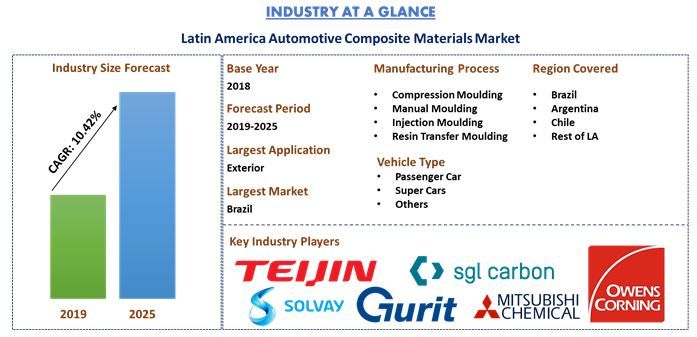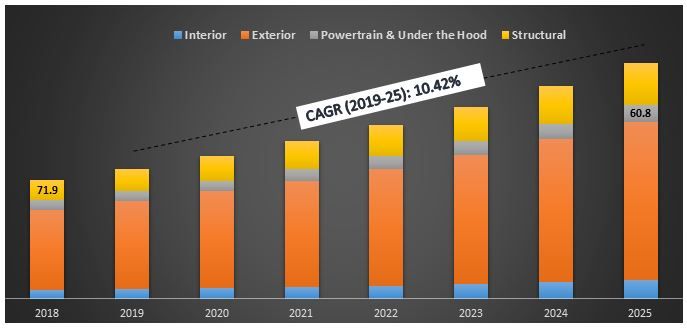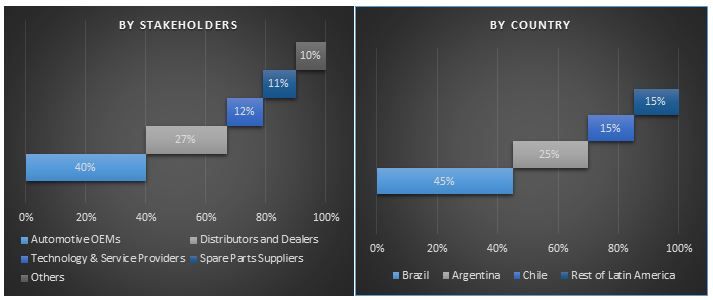라틴 아메리카 자동차 복합 재료 시장 인사이트: 인사이트 및 예측, 2019-2025
재료 유형 강조 (고분자 매트릭스 복합재료, 금속 매트릭스 복합재료, 세라믹 매트릭스 복합재료 및 하이브리드 복합재료), 제조 공정 (수적층, 압축 성형, 사출 성형, 수지 이송 성형)
라틴 아메리카 자동차 복합 소재 시장은 2018년에 4억 1,660만 달러로 평가되었으며 예측 기간(2019-2025) 동안 10.42의 적절한 CAGR을 나타내며 2025년까지 8억 2,780만 달러에 이를 것으로 예상됩니다. 라틴 아메리카 대부분 국가의 자동차 산업은 지난 몇 년 동안 신차 등록 수가 증가했습니다. 그러나 이러한 차량 수 증가는 환경에서 온실 가스(GHG) 배출량을 증가시켰습니다. 또한 라틴 아메리카의 운송 산업은 높은 수준의 CO2 배출에 대한 주요 기여자입니다. 이 지역의 심각한 GHG 수준으로 인해 브라질, 아르헨티나, 칠레 등과 같은 국가들은 향후 GHG 수준을 특정 수준으로 줄이겠다고 약속했습니다. 이러한 이니셔티브는 지역 내 자동차 제조업체들이 복합 재료를 모델에 배치하도록 동기를 부여했는데, 복합 재료는 차량의 전체 무게를 줄이고 연비 효율을 높이기 때문입니다. 라틴 아메리카는 대부분의 자동차 OEM 및 복합 재료 공급업체가 잠재적인 주요 사업 영역 중 하나입니다. 따라서 이들 업체는 가능한 기회를 활용하기 위해 이 지역에서 사업을 확장하고 있습니다. 이러한 요인들은 이 지역의 자동차 복합 재료 시장을 확장시키는 데 기여합니다. 그러나 원자재, 제조 공정 및 설치와 관련된 높은 비용은 시장 성장을 저해하는 주요 과제입니다.
"고분자 매트릭스 복합재는 분석 기간 동안 우위를 점할 것으로 예상됩니다."
라틴 아메리카 자동차 복합재료 시장은 고분자 매트릭스 복합재(PMC), 금속 매트릭스 복합재(MMC), 세라믹 매트릭스 복합재(CMC) 및 하이브리드 복합재와 같은 다양한 재료를 기반으로 세분화됩니다. 현재 PMC는 유연성이 높고 절연성이 높으며 밀도가 낮고 다른 복합 재료 유형보다 가볍기 때문에 자동차 제조업체들 사이에서 가장 인기 있는 복합재 유형입니다. 또한 PMC에 대한 심층 분석을 위해 해당 세그먼트는 열경화성 수지 및 열가소성 수지를 포함하는 매트릭스 유형별로 더 세분화됩니다. 그러나 하이브리드 복합재의 저렴한 비용과 뛰어난 구조적 및 기계적 특성으로 인해 단일 섬유 복합재의 대안이 되고 있습니다. 따라서 하이브리드 복합재는 예측 기간 동안 가장 빠르게 성장하는 세그먼트가 될 것으로 예상됩니다.
"열경화성 수지는 2018년에 가장 큰 시장 점유율을 차지했으며 2025년에도 시장을 지배할 것으로 예상됩니다."
이 연구는 또한 PMCs를 열경화성 수지 및 열가소성 수지를 포함하는 매트릭스 유형별로 분류합니다. 열경화성 수지는 2018년에 가장 큰 시장 점유율을 차지했으며 2025년까지 시장을 지배할 것으로 예상됩니다. 그러나 열가소성은 컴팩트하고 무선이기 때문에 예측 기간 동안 가장 높은 성장을 기록할 것으로 예상됩니다.
"제조 공정 중에서 사출 성형이 가장 큰 시장 점유율을 차지할 것으로 예상되며 2025년까지 라틴 아메리카 자동차 복합 재료 시장을 지배할 것입니다."
라틴 아메리카 자동차 복합재료 시장은 다양한 제조 공정으로 더욱 세분화됩니다. 여기에는 수작업 레이업, 압축 성형, 사출 성형 및 수지 전달 성형(RTM)이 포함됩니다. 사출 성형 공정은 2018년에 시장을 지배했으며 저비용 및 대량 생산이 가능한 RTM의 기능으로 인해 예측 기간(2018-2025) 동안 계속해서 지배력을 유지할 것으로 예상됩니다.
"응용 분야 중에서 외부 세그먼트는 2025년까지 라틴 아메리카 자동차 복합 재료 시장을 지배할 것으로 예상됩니다."
자동차의 응용 분야를 기반으로 라틴 아메리카 자동차 복합 재료 시장은 내부, 외부, 섀시, 파워트레인 및 후드 아래 및 구조로 세분화됩니다. 라틴 아메리카의 자동차 산업은 북미의 영향을 많이 받기 때문에 북미의 차량 내부 공기질에 대한 엄격한 규제는 라틴 아메리카의 차량 내부에 대한 복합재 수요를 촉진할 것으로 예상됩니다. 이로 인해 라틴 아메리카 내부 응용 시장은 예측 기간 동안 가장 빠르게 성장하는 시장이 될 것으로 예상됩니다.
응용 분야별 라틴 아메리카 자동차 복합 재료 시장 규모, 2018-25년(미화 백만 달러)
"차량 유형 중에서 승용차가 라틴 아메리카 자동차 복합 재료 시장에서 가장 큰 점유율을 차지합니다."
다양한 차량 유형을 기반으로 라틴 아메리카 자동차 복합 재료 시장은 고성능 자동차, 승용차 및 기타(상용차 및 기타)로 세분화됩니다. 승용차 세그먼트는 2018년에 최대 시장 점유율을 차지했으며 예측 기간 동안 시장을 계속 지배할 것입니다.
"브라질은 라틴 아메리카 자동차 복합 재료 시장에서 가장 큰 시장 중 하나입니다."
산업에 대한 심층 분석을 위해 라틴 아메리카 자동차 복합 재료 시장은 브라질, 아르헨티나, 칠레 및 나머지 LATAM을 포함한 다양한 국가로 더욱 세분화됩니다. 중국은 2018년에 시장을 지배했으며 예측 기간 동안 다른 시장을 지배할 것으로 예상됩니다. 브라질은 2018년에 시장 가치로 시장을 지배했습니다.
경쟁 환경-상위 10개 시장 참여자
BASF SE, DowDupont Inc., Gurit Holding AG, Magna International Inc., Mitsubishi Chemical Holdings Corporation, Owens Corning, SGL Group, Solvay SA, Teijin Limited 및 Toray Industries Inc.는 자동차 복합재 시장 산업에서 활동하는 주요 업체 중 일부입니다. 주요 업체 중 일부는 새로운 공장을 설립하거나 저렴한 제조 방법을 개발하기 위해 R&D에 대한 지출을 늘려 사업을 확장하고 있습니다. 이러한 업체는 고객에게 첨단 기술과 혁신적인 제품을 제공하기 위해 여러 M&A와 파트너십을 체결했습니다.
구매 이유:
- 2018년부터 2025년까지의 현재 및 미래 시장 규모(가치 기준: 미화 달러)
- 심층 2차 연구와 업계의 핵심 오피니언 리더를 통한 1차 연구의 결합 분석
- 라틴 아메리카에서 자동차 복합 재료 시장의 전반적인 채택에 대한 국가 수준 세부 정보
- 한눈에 볼 수 있는 전반적인 산업 성과에 대한 간략한 검토
- 주요 산업 플레이어에 대한 심층 분석
- 업계에 만연한 동인, 제약, 주요 추세 및 기회에 대한 자세한 분석
- Porter의 Five Forces 분석을 통한 산업 매력도 조사
- 이 연구는 기술의 다양한 세그먼트 및 하위 세그먼트에 걸쳐 시장을 포괄적으로 다룹니다.
- 적용 국가: 브라질, 아르헨티나 및 칠레
맞춤 설정 옵션:
UMI는 귀하가 자체적인 비즈니스 요구 사항을 가질 수 있음을 이해하므로 고객에게 완벽하게 맞춤화된 솔루션도 제공합니다. 라틴 아메리카 자동차 복합재 시장은 국가 수준 또는 기타 시장 세그먼트로 맞춤 설정할 수 있습니다.
목차
라틴 아메리카 자동차 복합 소재에 대한 역사적 시장 분석, 현재 시장 추정 및 미래 시장 예측은 라틴 아메리카 주요 국가에서 자동차 복합 소재의 전반적인 채택률을 생성하고 분석하는 동안 고려된 세 가지 주요 단계였습니다. 기술의 역사적 시장 및 현재 시장의 전반적인 추정을 수집하기 위해 광범위한 2차 조사를 수행했습니다. 둘째, 이러한 통찰력을 검증하기 위해 수많은 결과 및 가정을 고려했습니다. 또한 라틴 아메리카 자동차 복합 소재 시장의 가치 사슬 전반에 걸쳐 업계 전문가와 광범위한 1차 인터뷰를 진행했습니다. 모든 가정, 시장 규모 및 1차 인터뷰를 통한 시장 수치 검증 후, 하향식 접근 방식을 사용하여 라틴 아메리카 자동차 복합 소재 시장의 전체 시장 규모를 예측했습니다. 그 후, 시장 분석 및 데이터 삼각 측량 방법을 채택하여 기술의 세그먼트 및 하위 세그먼트의 시장 규모를 추정하고 분석했습니다. 자세한 방법론은 아래에 설명되어 있습니다.
역사적 시장 규모 분석
1단계: 2차 자료 심층 연구:
연간 보고서 및 재무 제표, 실적 발표, 보도 자료, 재고 기록, 판매 수치 등과 같은 회사 내부 소스 및 무역 저널, 뉴스 기사, 정부 간행물, 국제 자동차 제조 기구, 경쟁업체 간행물, 부문 보고서, 규제 기관 간행물, 안전 표준 기관, 타사 데이터베이스 및 기타 신뢰할 수 있는 간행물을 포함한 외부 소스를 통해 라틴 아메리카 자동차 복합 소재 시장의 역사적 시장 규모를 얻기 위해 자세한 2차 연구를 수행했습니다.
2단계: 시장 세분화:
전반적인 시장의 역사적 시장 규모를 확보한 후, 라틴 아메리카 자동차 복합 소재 시장의 다양한 세그먼트 및 하위 세그먼트에 대한 역사적 시장 통찰력과 점유율을 수집하기 위해 자세한 2차 분석을 수행했습니다. 보고서에 포함된 주요 세그먼트는 재료 유형, 제조 공정, 응용 분야 및 차량 유형입니다.
3단계: 요인 분석:
다양한 세그먼트 및 하위 세그먼트의 역사적 시장 규모를 확보한 후, 라틴 아메리카 자동차 복합 소재 시장의 현재 시장 규모를 추정하기 위해 자세한 요인 분석을 수행했습니다. 요인 분석은 라틴 아메리카 주요 국가의 구매력, 정부 이니셔티브, 정부 규제와 같은 종속 변수 및 독립 변수를 사용하여 수행했습니다. 자동차 복합 소재의 역사적 추세와 최근 시장 규모 및 점유율에 대한 연간 영향이 분석되었습니다. 수요 및 공급 측면 시나리오도 철저히 연구했습니다.
현재 시장 규모 추정 및 예측
현재 시장 규모 측정: 위의 3단계에서 얻은 실행 가능한 통찰력을 바탕으로 현재 시장 규모, 시장의 주요 업체, 이러한 업체의 시장 점유율, 산업의 공급망 및 산업의 가치 사슬에 도달했습니다. 필요한 모든 백분율 점유율, 분할 및 시장 분석은 위에서 언급한 2차 접근 방식을 사용하여 결정되었으며 1차 인터뷰를 통해 확인되었습니다.
추정 및 예측: 시장 추정 및 예측을 위해 시장에서 사용 가능한 동인, 제약, 추세 및 기회를 포함한 다양한 요인에 가중치를 부여했습니다. 이러한 요인을 분석한 후 관련 예측 기술, 즉 하향식/상향식을 적용하여 라틴 아메리카 주요 국가의 다양한 세그먼트 및 하위 세그먼트에 대한 2025년 시장 예측에 도달했습니다. 시장 규모를 추정하기 위해 채택된 연구 방법론은 다음과 같습니다.
- 주요 라틴 아메리카 국가에서 가치(미화 달러) 및 자동차 복합 소재 채택률 측면에서 산업의 시장 규모
- 시장 세그먼트 및 하위 세그먼트의 모든 백분율 점유율, 분할 및 분석
- 다양한 기술 및 시장에 걸친 주요 업체와 각 업체의 시장 점유율. 또한 빠르게 성장하는 라틴 아메리카 자동차 복합 소재 시장에서 경쟁하기 위해 이러한 업체가 채택한 성장 전략
시장 규모 및 점유율 검증
1차 연구: 최고 경영진(CXO/VP, 영업 책임자, 마케팅 책임자, 운영 책임자 및 지역 책임자 등)을 포함한 주요 오피니언 리더(KOL)와 심층 인터뷰를 진행했습니다. 1차 연구 결과를 요약하고 언급된 가설을 증명하기 위해 통계 분석을 수행했습니다. 1차 연구의 투입물을 2차 결과와 통합하여 정보를 실행 가능한 통찰력으로 전환했습니다.
1차 참가자 분할
시장 엔지니어링
데이터 삼각 측량 기술을 사용하여 전체 시장 엔지니어링 프로세스를 완료하고 라틴 아메리카 자동차 복합 소재 시장과 관련된 각 세그먼트 및 하위 세그먼트의 정확한 통계 수치에 도달했습니다. 재료 유형, 제조 공정, 응용 분야 및 차량 유형 분야의 다양한 매개변수 및 추세를 연구한 후 데이터를 여러 세그먼트 및 하위 세그먼트로 분할했습니다.
라틴 아메리카 자동차 복합 소재 시장 조사의 주요 목표
라틴 아메리카 자동차 복합 소재 시장의 현재 및 미래 시장 동향이 연구에서 정확히 지적됩니다. 투자자는 연구에서 수행된 질적 및 양적 분석에서 투자를 위한 재량을 근거로 전략적 통찰력을 얻을 수 있습니다. 현재 및 미래 시장 동향은 시장의 전반적인 매력도를 결정하여 산업 참가자가 미개척 시장을 활용하여 최초 진입자 이점을 누릴 수 있는 플랫폼을 제공합니다. 연구의 다른 양적 목표는 다음과 같습니다.
- 가치(미화 달러) 측면에서 라틴 아메리카 자동차 복합 소재의 현재 및 예측 시장 규모 분석
- 라틴 아메리카 자동차 복합 소재 시장의 다양한 세그먼트 및 하위 세그먼트의 현재 및 예측 시장 규모 분석. 연구의 세그먼트는 재료 유형, 제조 공정, 응용 분야 및 차량 유형을 포함합니다.
- 자동차 복합 소재에 사용되는 기술 및 프로토콜 정의 및 설명
- 무엇보다도 고객 및 경쟁업체 분석과 함께 기술과 관련된 잠재적 위험 예측
- 라틴 아메리카 주요 국가의 자동차 복합 소재에 대한 정부 규정 정의 및 분석
- 브라질, 아르헨티나, 칠레 및 기타 라틴 아메리카 국가를 포함하여 가치 측면에서 라틴 아메리카 지역의 자동차 복합 소재의 현재 및 예측 시장 규모 분석
- 라틴 아메리카 자동차 복합 소재의 경쟁 환경과 끊임없이 성장하는 시장에서 유지하기 위해 시장 참가자가 채택한 성장 전략 정의 및 분석
관련 보고서
이 상품을 구매한 고객님들도 함께 구매하신 상품













